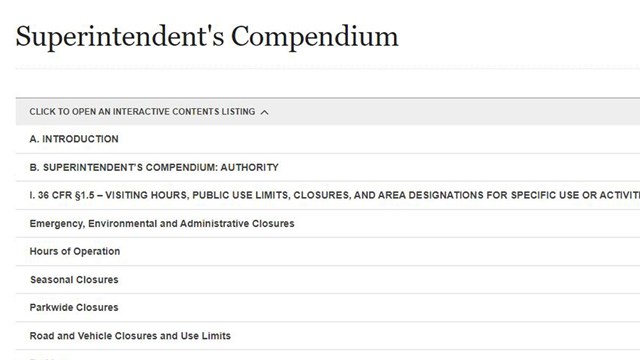Acadia Specific RegulationsWithin 36 CFR, park superintendents are granted the right to make park-specific regulations to maintain public health and safety, protect environmental or scenic values, protect natural and cultural resources, aid in scientific research, provide for equitable use of facilities, and avoid conflict among visitor use activities. 
Superintendent's Compendium
Explore the Superintendent's Compendium, which provides rules and regulations for park operations and visitors. 
Park Rules & Regulations
Are visitors allowed to harvest mushrooms, or fly a drone in Acadia? Check out highlights of the park's important Rules and Regulations. National Park Service Regulations and PolicyRegulationsPark rangers enforce a number of federal regulations in the park, including the:
Guidance and PolicyAcadia National Park Service also follows: LawsAcadia National Park is a unit of the National Park Service, which is a unit of the Department of the Interior. The Department of the Interior is a branch of the Executive Branch of the United States government. It is therefore subject to all the laws of the federal government pertaining to the Executive Branch and specific laws related to the National Park Service.Acadia National Park also has specific laws that apply only to Acadia. Park Enabling LegislationPark enabling legislation are the laws that establish the park. Acadia has three primary pieces of enabling legislation: 1916 - Presidential ProclimationAcadia National Park officially began with the establishment of Sieur de Monts National Monument by Presidential Proclamation 1339 in 1916. 1919 - Name Change to Lafayette National Park.The name was changed in 1919 to Lafayette National Park (40 Stat. 1173). 1929 - Name Change to Acadia National ParkThe January 19, 1929 law PL 70-667 (45 Stat. 1083) changed the park name to Acadia National Park. It also established the authority to expand the park through donations of property within Hancock County and certain islands in Knox County.
These multiple pieces of legislation, along with the nature of the park's founding from donated land, led to a park that had no permanent boundary and no authority to purchase additional lands. As property was donated, a fragmented patchwork of parklands developed. Lands were scattered, making management, protection, and visitor orientation difficult. Local towns were frustrated by the constant threat of unexpected donations eroding their tax bases. This would result in ongoing discussions about the park boundary for generations that required future legislation. Today, land and boundary management is a continuous duty performed by park staff.
1982 Boundary LegislationFor many years the National Park Service, the towns, the Hancock County Planning Commission, and numerous conservation groups attempted to resolve these issues through arduous negotiations.In 1982 separate boundary legislation (PL 97‑335) was approved for parkland in the town of Isle au Haut and, subsequently, a development concept plan was approved for the parkland. 1986 Boundary LegislationOn September 25, 1986, boundary legislation (PL 99‑420) was enacted for the rest of Acadia National Park. The law defined a permanent boundary and gave the National Park Service authority to acquire lands, but only within the designated boundary of Acadia National Park; it identified approximately 175 tracts for acquisition and 24 for deletion.(This authority does not apply to the town of Isle au Haut; acquisition of land within the boundaries of this town continues to be covered by the authority outlined in PL 97‑335). The legislation outlined conditions for acquiring conservation easements outside the boundary and established an advisory commission. Laws Related to the Transfer of the Schoodic Navy BaseStarting with the transfer of the Schoodic Navy Base to the National Park Service in the 2001 National Defense Authorization Act, many laws additional have been passed to formalize the transfer of this land to Acadia National Park.2008 Acadia Improvement ActThe 2008 Acadia Improvement Act further defined the park boundary, extended the Acadia Advisory Commission, and authroized the park to provide assistance to the Acadia Gateway Center project.2019 Boundary LawSection 2108 of the 2019 John D. Dingell, Jr. Conservation, Management, and Recreation Act continued to define the park boundary. |
Last updated: April 25, 2022
